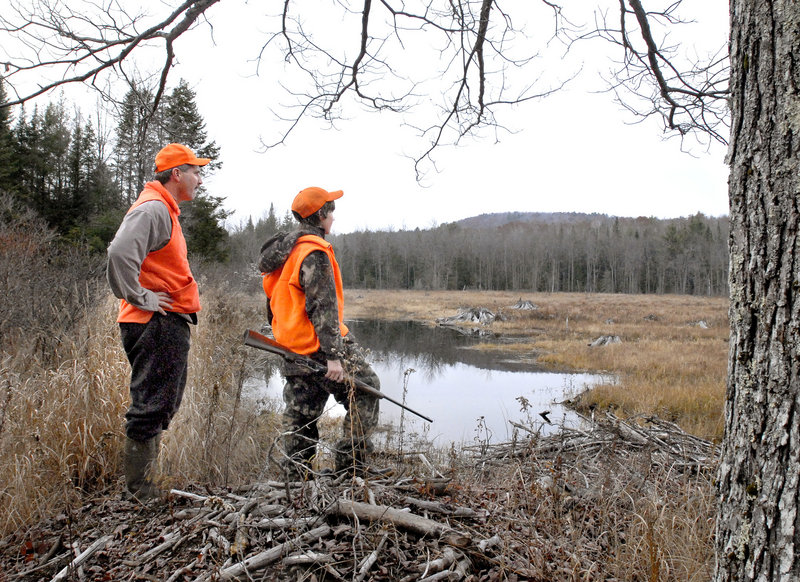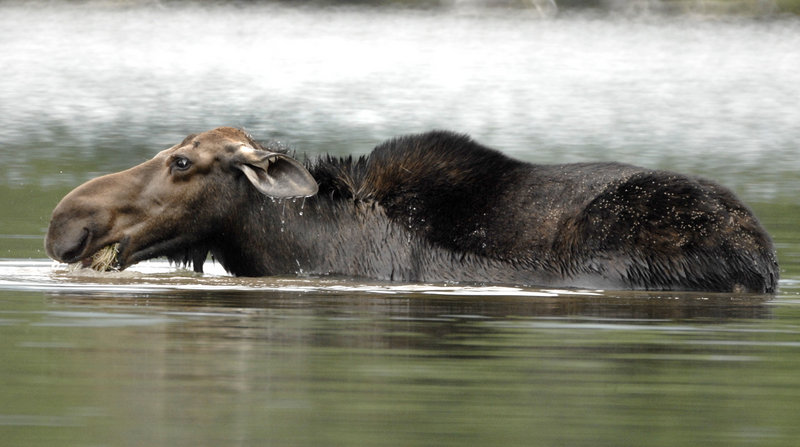The second installment of Maine’s 2011 moose season kicks off tomorrow.
The hunt has become something of an institution, as a generation of Mainers now has grown up with a chance — albeit a slim one — to participate. That wasn’t always the case, and this tremendous recreational opportunity did not come to be without its share of growing pains.
For as long as they’ve been in Maine, two-legged predators have pursued North America’s largest deer. Bill Krohn’s book, “Manly Hardy (1832-1910): The Life and Writing of a Maine Fur-buyer, Hunter, and Naturalist” provides an early historical perspective.
In a 1907 passage Hardy wrote, “Until within 60 years most of the moose were killed by Indians, and were taken in one of three ways. In summer by shooting them when feeding in the water (which was mostly done by night); in fall by calling them; and in winter by running them down on snowshoes when the snow was deep.”
Moose hunting continued without restriction until 1830, when Maine established an open season of two months.
Over the next 14 years, season lengths varied from two to eight months, and Hardy observed: “The greatest slaughter of moose was in 1861, and they reached their lowest point between then and 1870.”
The next four decades were characterized by changes in season length and bag limits and periodic closures. A six-day season allowing one bull moose per hunter was intermittently closed and re-opened from 1920-1936, and then was no hunt for 44 years.
After several failed attempts, the Legislature passed a bill in 1979 allowing the Department of Inland Fisheries and Wildlife (IFW) to issue up to 700 permits to resident hunters for a six-day season — restricted to an area north of the Canadian Pacific Railroad.
Since then, the season has grown in terms of permit numbers, duration and area, though not without controversy.
EFFORT TO STOP IT
The new hunt was barely three years young when a group called Save Maine’s Only Official State Animal (SMOOSA) — funded largely by out-of-state anti-hunting groups — tried to scuttle it through a referendum on the state’s ballot.
Opposition, led principally by the Sportsman’s Alliance of Maine (SAM) and its offshoot, the Council for Sensible Game Management, was bolstered by an informational bulletin from the Maine Chapter of the Wildlife Society and a pamphlet from the Wildlife Management Institute. This information from professional wildlife biologists added enough credibility to help defeat the referendum by a comfortable margin.
The next big changes came largely as a result of a public working group, convened by IFW and charged with developing a comprehensive management plan. The Legislature finally released its grip on the number of moose permits IFW could issue, effectively handing over control of the moose herd to state biologists.
This gave biologists much greater flexibility, and the ability to manage on a smaller, more precise scale, which became more important when the seven moose hunting zones were subdivided into more, smaller management districts.
It effectively began what big-game biologist Lee Kantar described as a whole new planning horizon. One of the first big changes was from any-moose permits to antlerless-only and bull-only permits.
“That gave us a finer ability to dictate the percentage of bulls and cows to be harvested in certain districts,” said Kantar.
Management now specifies what the population should look like in each district and what the bull component should look like in terms of age and proportion.
The new plan puts each district in one of three categories, based on management goals. Hunting and viewing opportunities are the most important goals in the recreation management area. Reducing moose/vehicle collisions is the only goal in the road safety area, while the compromise management area balances recreation and safety.
EXPANSION IN SOUTHERN MAINE
Significant changes have come more quickly of late.
In 2008, IFW opened four southern districts to some level of moose hunting, and the next year began a controlled moose hunt in Aroostook County.
In 2010 they added a week-long November hunt in some districts and this year added districts 22 and 25 to the month-long southern Maine hunt.
“This really is a new and very productive stage for Maine moose management,” says Kantar. “We have a tremendous amount of data on cow and bull adult sex ratios from aerial surveys. We will continue to get data from more districts and correlate that with hunter sighting results.”
Biologists are also collecting reproductive data from the November season and cow/calf ratios from winter helicopter surveys with the ultimate goal of combining all data to get the larger picture.
“We should be looking pretty sharp in 2012,” says Kantar, “which should be great news for Maine moose hunters. The more we know about moose, the more we are able to work with the permits.”
IFW is also working with New Hampshire, and with the University of Maine’s diagnostic lab on moose tick and lung worm infestation.
“Maine is really starting to lead the charge on moose management and biology,” said Kantar. “We’re trying to do a lot of good things.”
Bob Humphrey is a freelance writer and registered Maine Guide who lives in Pownal. He can be contacted at:
bhhunt@maine.rr.com
Copy the Story Link
Send questions/comments to the editors.




Success. Please wait for the page to reload. If the page does not reload within 5 seconds, please refresh the page.
Enter your email and password to access comments.
Hi, to comment on stories you must . This profile is in addition to your subscription and website login.
Already have a commenting profile? .
Invalid username/password.
Please check your email to confirm and complete your registration.
Only subscribers are eligible to post comments. Please subscribe or login first for digital access. Here’s why.
Use the form below to reset your password. When you've submitted your account email, we will send an email with a reset code.